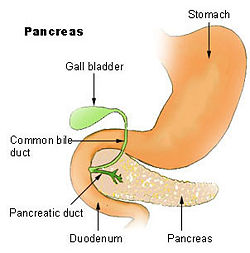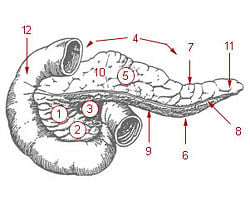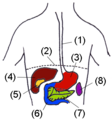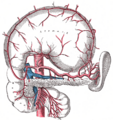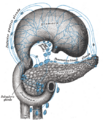Difference between revisions of "Pancreas" - New World Encyclopedia
Donald Mull (talk | contribs) |
Donald Mull (talk | contribs) |
||
| Line 21: | Line 21: | ||
}} | }} | ||
| − | The '''pancreas''' is a glandular organ found in vertebrates | + | The '''pancreas''' is a pinkish white glandular organ found in vertebrates. It has both an exocrine function - secreting [[pancreatic juice]] containing [[Digestion|digestive]] [[enzyme]]s) and an [[endocrine system|endocrine]] function - producing several important [[hormone]]s, including [[insulin]], [[glucagon]], and [[somatostatin]]. |
==Anatomy== | ==Anatomy== | ||
| − | In adult human beings, the pancreas is a 6-10 inch elongated organ in | + | In adult human beings, the pancreas is a 6-10 inch elongated organ weighing about 160 grams and lying in the abdominal cavity ; posterior to the [[stomach]] and in close association with the [[duodenum]]. |
It is often described as having three regions: a head, body and tail. | It is often described as having three regions: a head, body and tail. | ||
| − | * The | + | * The pancreatic head touches the duodenum. |
| − | * The | + | * The body of the pancreas lies at the level of second lumbar vertebrae of the spine. |
| − | * The | + | * The tail of the pancreas extends towards the [[spleen]]. |
| − | The | + | The pancreatic duct or duct of Wirsung runs the length of the pancreas and empties into the second part of the duodenum at the ampulla of Vater. The common bile duct usually joins the pancreatic duct at or near this point. |
| − | Many people also have a small accessory duct, the | + | Many people also have a small accessory duct, the duct of Santorini, which extends from the main duct more upstream (towards the tail) to the duodenum, joining it more proximally than the ampulla of Vater. |
==Arteries and veins== | ==Arteries and veins== | ||
| − | The pancreas is supplied | + | The pancreas is supplied arterially by the pancreaticoduodenal arteries: |
* the [[superior mesenteric artery]] provides the [[inferior pancreaticoduodenal arteries]] | * the [[superior mesenteric artery]] provides the [[inferior pancreaticoduodenal arteries]] | ||
* the [[gastroduodenal artery]] provides the [[superior pancreaticoduodenal artery]] | * the [[gastroduodenal artery]] provides the [[superior pancreaticoduodenal artery]] | ||
| − | + | Venous drainage is via the [[pancreaticoduodenal veins]] which end up in the [[portal vein]]. The [[splenic vein]] passes posterior to the pancreas but is said to not drain the pancreas itself. The [[portal vein]] is formed by the union of the [[superior mesenteric vein]] and [[splenic vein]] posterior to the neck of the pancreas. In some people (some books say 40% of people), the [[inferior mesenteric vein]] also joins with the [[splenic vein]] behind the pancreas (in others it simply joins with the [[superior mesenteric vein]] instead). | |
==Function== | ==Function== | ||
| − | Under a microscope, when properly stained, it is easy to distinguish | + | Under a microscope, when properly stained, it is easy to distinguish different types of cells in the pancreas. These regions correspond to the main pancreatic functions: |
{| class="wikitable" | {| class="wikitable" | ||
Revision as of 23:58, 10 May 2007
| Pancreas | |
|---|---|
| 1: Head of pancreas 2: Uncinate process of pancreas 3: Pancreatic notch 4: Body of pancreas 5: Anterior surface of pancreas 6: Inferior surface of pancreas 7: Superior margin of pancreas 8: Anterior margin of pancreas 9: Inferior margin of pancreas 10: Omental tuber 11: Tail of pancreas 12: Duodenum | |
| Gray's | subject #251 1199 |
| Artery | Inferior pancreaticoduodenal artery, Superior pancreaticoduodenal artery |
| Vein | Pancreaticoduodenal veins |
| Nerve | Pancreatic plexus, celiac ganglia, vagus[1] |
| Precursor | pancreatic buds |
| MeSH | Pancreas |
| Dorlands/Elsevier | p_02/ |
The pancreas is a pinkish white glandular organ found in vertebrates. It has both an exocrine function - secreting pancreatic juice containing digestive enzymes) and an endocrine function - producing several important hormones, including insulin, glucagon, and somatostatin.
Anatomy
In adult human beings, the pancreas is a 6-10 inch elongated organ weighing about 160 grams and lying in the abdominal cavity ; posterior to the stomach and in close association with the duodenum.
It is often described as having three regions: a head, body and tail.
- The pancreatic head touches the duodenum.
- The body of the pancreas lies at the level of second lumbar vertebrae of the spine.
- The tail of the pancreas extends towards the spleen.
The pancreatic duct or duct of Wirsung runs the length of the pancreas and empties into the second part of the duodenum at the ampulla of Vater. The common bile duct usually joins the pancreatic duct at or near this point. Many people also have a small accessory duct, the duct of Santorini, which extends from the main duct more upstream (towards the tail) to the duodenum, joining it more proximally than the ampulla of Vater.
Arteries and veins
The pancreas is supplied arterially by the pancreaticoduodenal arteries:
- the superior mesenteric artery provides the inferior pancreaticoduodenal arteries
- the gastroduodenal artery provides the superior pancreaticoduodenal artery
Venous drainage is via the pancreaticoduodenal veins which end up in the portal vein. The splenic vein passes posterior to the pancreas but is said to not drain the pancreas itself. The portal vein is formed by the union of the superior mesenteric vein and splenic vein posterior to the neck of the pancreas. In some people (some books say 40% of people), the inferior mesenteric vein also joins with the splenic vein behind the pancreas (in others it simply joins with the superior mesenteric vein instead).
Function
Under a microscope, when properly stained, it is easy to distinguish different types of cells in the pancreas. These regions correspond to the main pancreatic functions:
| Appearance | Region | Function |
| light staining circles (islets of Langerhans) | endocrine pancreas | secretes hormones that regulate blood glucose levels |
| darker surrounding tissue | exocrine pancreas | produces enzymes that break down digestible foods |
Endocrine
There are four main types of cells in the islets of Langerhans. They are relatively difficult to distinguish using standard staining techniques, but they can be classified by their secretion:
| Name of cells | Product | % of islet cells | Representative function |
| beta cells | Insulin and Amylin | 50-80% | lower blood sugar |
| alpha cells | Glucagon | 15-20% | raise blood sugar |
| delta cells | Somatostatin | 3-10% | inhibit endocrine pancreas |
| PP cells | Pancreatic polypeptide | 1% | inhibit exocrine pancreas |
The islets are a compact collection of endocrine cells arranged in clusters and cords and are crisscrossed by a dense network of capillaries. The capillaries of the islets are lined by layers of endocrine cells in direct contact with vessels, and most endocrine cells are in direct contact with blood vessels, by either cytoplasmic processes or by direct apposition.
The function of the pancreas is to produce important hormones including Insulsin, glucagon and somatostatin
Exocrine
There are two main classes of exocrine pancreatic secretions:
| Secretion | Cell producing it | Primary signal |
| bicarbonate ions | Centroacinar cells | Secretin |
| digestive enzymes (pancreatic amylase, trypsin, chymotrypsin, etc.) | Basophilic cells | CCK |
Diseases of the pancreas
Due to the importance of its enzyme contents, injury to the pancreas is potentially very dangerous. A puncture of the pancreas generally requires prompt and experienced medical intervention.
- Diabetes mellitus
- Benign tumours
- Pancreatic cancer, including
- Carcinoma of pancreas
- Insulinoma
- Glucagonoma
- Cystic fibrosis
- Exocrine pancreatic insufficiency
- Hemosuccus pancreaticus, or bleeding from or through the pancreatic duct
- Pancreatitis
- Acute pancreatitis
- Chronic pancreatitis
- Hereditary pancreatitis
- Pancreatic pseudocyst
History
The pancreas was discovered by Herophilus (335-280 B.C.E.), a Greek anatomist and surgeon. Only a few hundred years later, Ruphos, another Greek anatomist, gave the pancreas its name. The term "pancreas" is derived from the Greek pan, "all", and kreas, "flesh", probably referring to the organ's homogenous appearance.[2]
Diabetes and the Pancreas
A new discovery might have important implications for treatment of diabetes. Researchers at the Toronto Hospital for Sick Children injected capsaicin into NOD mice (Non-obese diabetic mice, a strain that is genetically predisposed to develop the equivalent of type 1 diabetes) to kill the pancreatic sensory nerves. This treatment reduced the development of diabetes in these mice by 80%, suggesting a link between neuropeptides and the development of diabetes. When the researchers injected the pancreas of the diabetic mice with sensory neuropeptide (sP), they were cured of the diabetes for as long as 4 months. Also, insulin resistance (characteristic of type 2 diabetes) was reduced. These research results are in the process of being confirmed, and their applicability in humans will have to be established in the future. Any treatment that could result from this research is probably years away.
Pancreas as a food
Pancreases (specifically calf and lamb pancreases) are used in some meals often going by the name stomach sweetbreads.[3]
Pop culture references
Heywood Banks, who performs regularly on the Bob & Tom Show, recorded a song titled "The Pancreas," composed of doggerel verses that rather accurately, if facetiously, decribe the function of the pancreas. The lyrics include "Let's all sing a tribute to the pancreas...hey pancreas, have a nice day!"
Satiric singer "Weird Al" Yankovic has recently produced a song titled "Pancreas." It includes many lyrics about the functions of the organ as well as the names of various chemicals it produces, concluding, "I love my pancreas!" The song can be found on his 2006 album "Straight Outta Lynwood."
Additional images
ReferencesISBN links support NWE through referral fees
- ↑ Physiology at MCG 6/6ch2/s6ch2_30
- ↑ Harper, Douglas. Pancreas. Online Etymology Dictionary. Retrieved April 4, 2007.
- ↑ New Standard Encyclopedia, 1988. Volume P Page 68
| ||||||||
Template:Endocrine pancreas
Credits
New World Encyclopedia writers and editors rewrote and completed the Wikipedia article in accordance with New World Encyclopedia standards. This article abides by terms of the Creative Commons CC-by-sa 3.0 License (CC-by-sa), which may be used and disseminated with proper attribution. Credit is due under the terms of this license that can reference both the New World Encyclopedia contributors and the selfless volunteer contributors of the Wikimedia Foundation. To cite this article click here for a list of acceptable citing formats.The history of earlier contributions by wikipedians is accessible to researchers here:
The history of this article since it was imported to New World Encyclopedia:
Note: Some restrictions may apply to use of individual images which are separately licensed.
